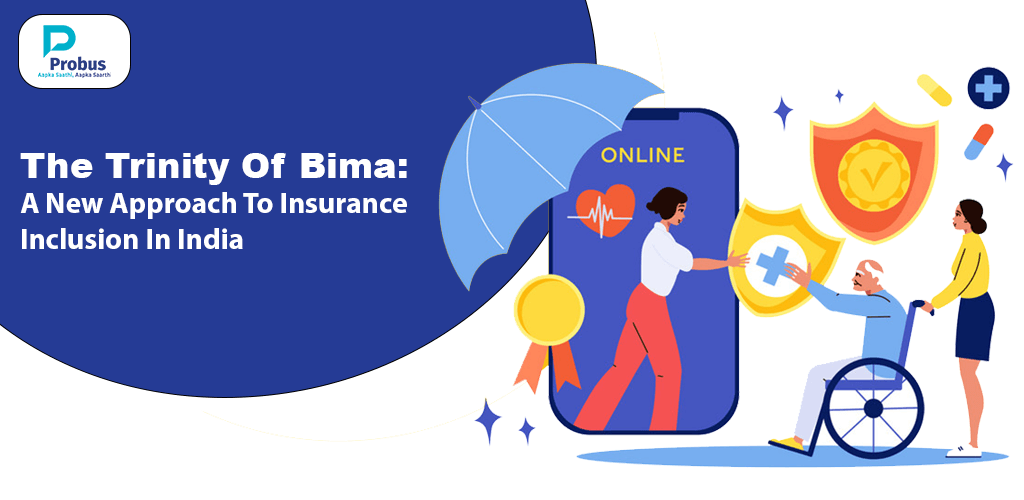India’s insurance sector witnessed a dynamic surge over the past few years. Though various reforms have been implemented to further fuel the sector’s growth, there is still a long way to go because the insurance penetration of India was only 4.2% of the GDP in the fiscal year 2021-22. India falls substantially short of the worldwide average of 7% of GDP in terms of penetration.
Amongst various determined attempts to streamline the country’s insurance sector, the Insurance Regulatory and Development Authority of India (IRDAI) is spearheading a three-pronged product, namely ‘Bima Trinity’. The initiative’s primary objectives are to address the country’s low insurance penetration, devise affordable and all-in-one insurance products, and streamline claim settlement processes.
This article will highlight the significance of ‘Bima Trinity’ and its crucial role in raising insurance inclusion in India. But before we do that, let’s have a brief discussion on what exactly it is!
What’s The Buzz About ‘Bima Trinity’?
The ‘Bima Trinity’ is a part of IRDAI’s vision, ‘Insurance For All By 2047’, which primarily aims to make the insurance processes in India hassle-free by effectively collaborating with general and life insurance companies.
The product will offer a bundled solution with health, life, accident, and property coverage while ensuring accessibility, affordability, and availability. The scheme also aims to create a robust claim settlement mechanism and reshape the nation’s insurance sector to make it globally attractive.
Let’s discuss each ‘Trinity’ plan in general!
1. Bima Vistaar:
It is Bima Trinity’s lynchpin product that provides comprehensive coverage under a single policy. One can just buy ‘Bima Vistaar’ and he/she is covered for his/her health, life, property, and accident. The plan is expected to launch in January 2024.
2. Bima Vaahaks:
IRDAI will appoint a women-centric workforce that will operate at the ‘Gram Sabha’ level to educate and convince women heads of various households about the benefits of comprehensive insurance like ‘Bima Vistaar’. This initiative will not only empower various women in the country but also enhance their financial security.
3. Bima Sugam:
It will be a one-stop shop platform that will bring insurers and distributors together. The primary aim of this unified platform is to provide a single and convenient portal to customers for simplifying policy purchases, claim settlements, and service requests. The launch date of the platform has been pushed late twice by IRDAI, first from January 2023 to August 2023 and then to June 2024.
Need Of ‘Bima Trinity’ In India
There are various reasons why initiatives like ‘Bima Trinity’ should be introduced in India. Some of them are discussed below:
Slow Digitalization Rate:
As compared to other sectors of India, the insurance industry has been lethargic in adopting digitalization. This has further given birth to various discrepancies, including lack of transparency, poor customer experience, and ineffective processes.
Poor Insurance Penetration:
As already discussed in the ‘intro’ part, even today, a large portion of the Indian population is uninsured. This is probably because they are either not aware or they no longer trust such products.
Lack Of Product Innovation:
The majority of insurers have been offering similar products with little to zero innovation. This has not only turned off the interests of policyseekers but also created a lack of diversification in the insurance market.
Slow & Complicated Claims Management:
Contrary to what insurance companies in India ensure, the claim processes are often slow, complicated, and greyish. Consequently, a large portion of customers have lost trust in the insurance industry.
Skyrocketing Insurance Prices:
Be it car insurance or health insurance, the premium costs are rising due to various factors, such as inflation and technological innovation. This has resulted in less public participation even after implementing a prolonged liberalization approach.
How ‘Bima Trinity’ Can Catalyse Insurance Inclusion In India?
India needs to deal smartly with low insurance penetration rates to harness the potential of the nation’s insurance sector. Here is how ‘Bima Trinity’ can attract more investment:
Identifying & Bridging Huge Protection Gaps:
According to IRDAI, there are huge protection gaps that exist in almost all the lines of insurance, be it health, motor, or life. The situation of ‘protection gaps’ arises when a policyholder does not have adequate, reasonably priced, and socially beneficial insurance. Such situations highlight the need for comprehensive coverage as well as faster claim settlements.
The ’Trinity’ will introduce comprehensive insurance products covering health, life, property, and accidents, that too, at pocket-friendly rates. Since these products will eliminate the need for surveyors, one can expect faster claim settlements. “If there is a loss, the defined benefit immediately goes to the bank account of the policyholder”, says IRDAI chief, Debasish Panda. The chief also wishes to integrate the IRDAI platform with digital birth and death registries of various states to help settle claims within 6 to 8 hours or a day at the most. These innovations will bridge the existing protection gaps in the nation.
Legislative Amendments For Making Insurance Attractive:
As a part of legislative reform, IRDAI has already stopped micro-management of expenses, repealed 70-odd regulations, canceled 1,000 circulars, and rationalized 79 returns in the last year. The initiative of ‘Bima Trinity’ is also a part of this broader overhaul, which includes legislative amendments for making insurance more appealing.
Some changes in the laws would be to allow insurers to offer various value-added services, like gym or yoga memberships, along with their policies; introduce differentiated capital requirements; and encourage new players and services. Such measures will introduce differentiation in the insurance sector and make it more inclusive for all citizens.
Increasing Availability, Affordability, & Accessibility:
IRDAI, through the ‘Bima Trinity’ initiative, is focused on increasing the 3As, Availability, Affordability, and Accessibility of insurance products to a larger population. The authority can do so by the following means:
- Offering comprehensive insurance coverage (Bima Vistaar) at affordable prices
- Providing a single platform of ‘Bima Sugam’ with various suitable options
- Offering real-time access to data
- Implementing the women-centric distribution model of ‘Bima Vaahaks’
- Promoting inclusive insurance
- Facilitating digital convenience
- Doubling the number of jobs in the sector
This dedication to the 3As is aligned with the authority’s primary objective of ensuring that all citizens are covered by insurance by 2047.
Creating UPI-Like Moment With Bundled Policies:
Presently, an insurance seeker has to buy health, car, life, and property insurance differently. This is significantly affecting the time, effort, money, and convenience of a policy seeker. In addition, these policies may or may not cover (protection gaps) what is required by an individual.
In response, IRDAI’s ‘Bima Trinity’ strives to create a revolutionary “UPI-like moment” for the insurance sector in India. Since the ‘Bima Trinity’ plan involves the collaboration of general as well as life insurers, it ensures to offer bundled insurance solutions for covering multiple risks under a single policy.
Moving Forward
The concept of ‘Bima Trinity’ has introduced a gamut of reforms that may transform India’s insurance sector from a monotonous to an interesting one. If this initiative fructifies, various households across the nation will leverage all-in-one and affordable policies, get their claims settled faster, secure their additional benefits like gym or yoga memberships, and even secure the financial future of their dependents.
The implementation of the scheme may pose significant social, economic, or technological challenges, but it holds the potential to increase insurance inclusion in India. The nation’s thriving economy and young and dynamic population will fuel this ‘Trinity Revolution’ in the insurance sector.








